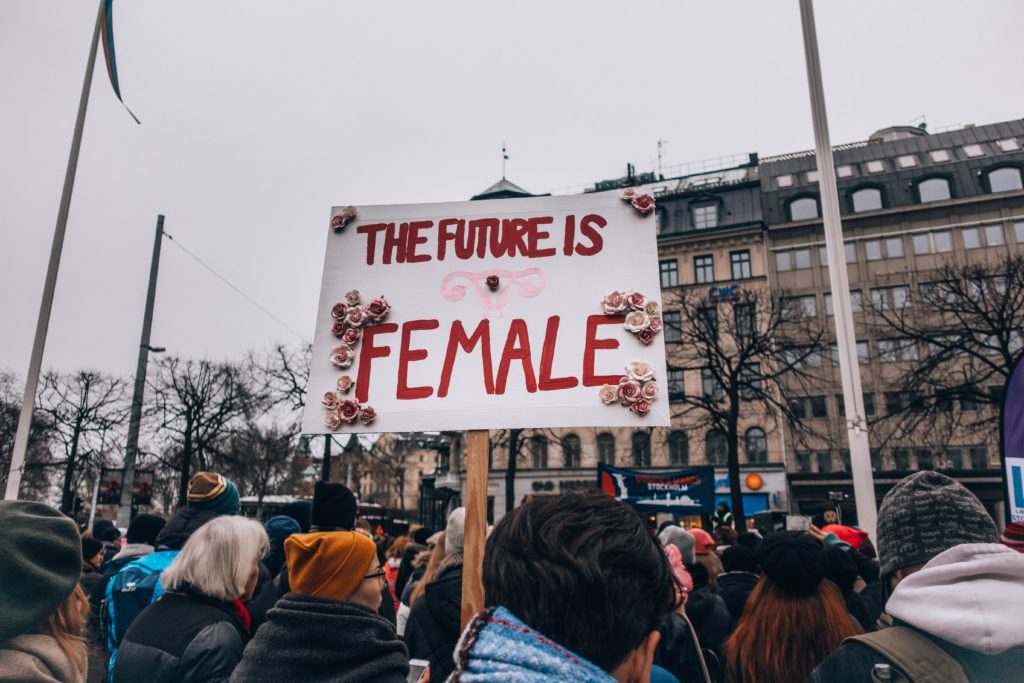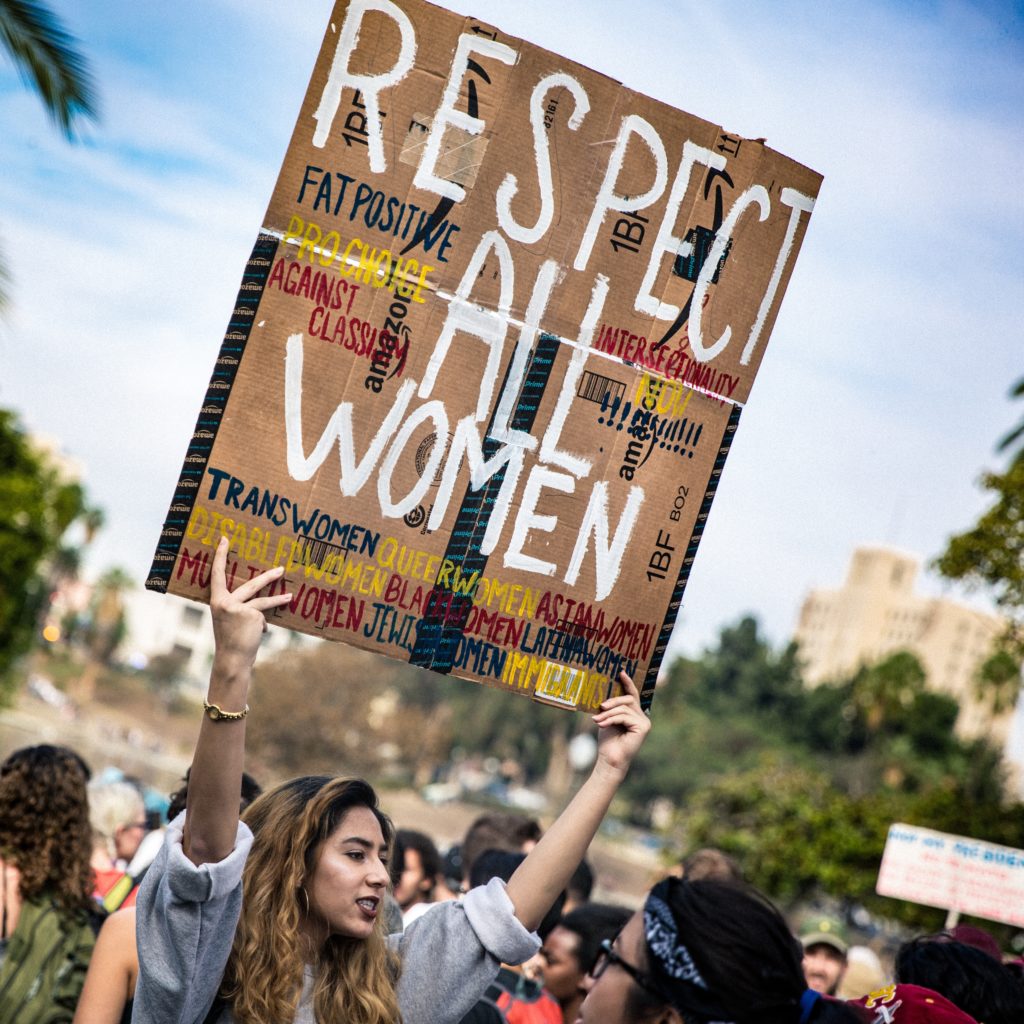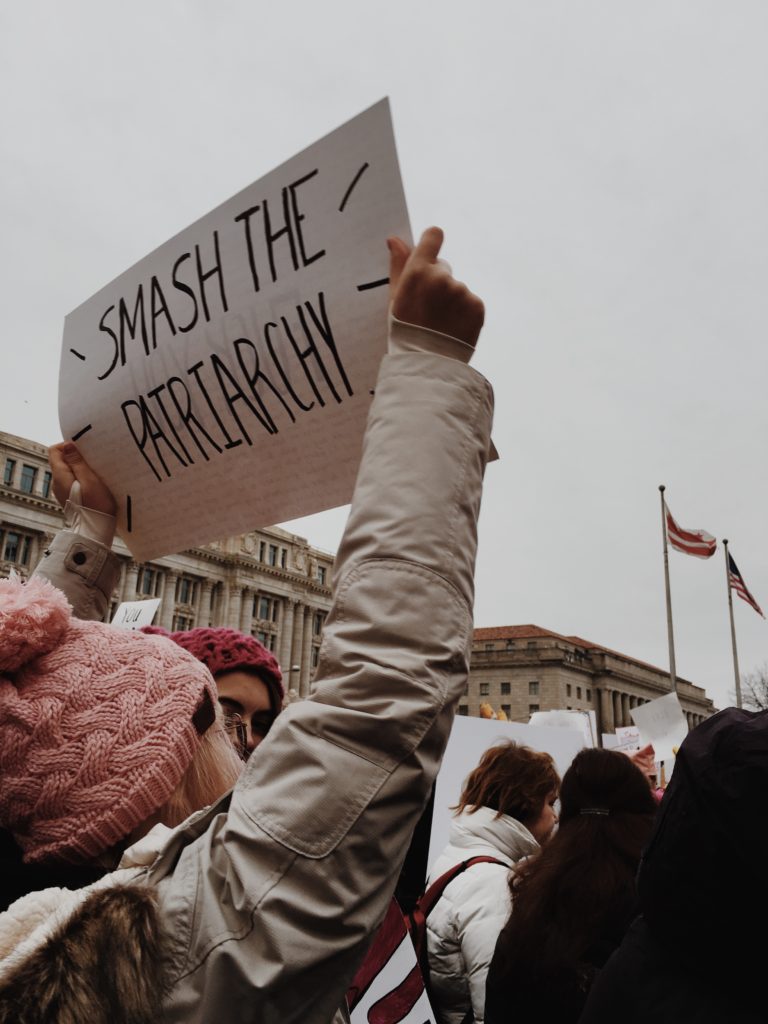
Photo by Lindsey LaMont on Unsplash
It’s difficult to believe women have had the right to vote for less than 100 years. To know that less than 50 years ago, I would not be able apply for my own mortgage is unthinkable. These realities were abolished thanks to feminist identity politics. Today we are looking at notable voices for and around feminism – and what they were saying then and now. For the purposes of this essay, we will look at the 1970’s forward, encompassing second- and third-wave feminism, then look at the current landscape.
Second-Wave Feminism
Second-wave feminism refers to the era of feminism taking place just after the civil rights era, starting in 1963 and stretching into the 1980’s. Women were re-entering the workforce for the first time since World War II, and fighting for equal employment and property rights, as well as agency over their reproductive health. The objective of this time-frame can be summed up in the goal of social equality; women were forcefully taking control of the direction and quality of their own lives.
Published in 1891, Charlotte Perkins Gilman’s haunting story shows the absolute train-wreck that was 18th-century mental health care. “The Yellow Wallpaper” became popular in the 1960’s for its themes of sexism and mistreatment of the mentally ill. The treatment and prevailing wisdom of the day is reminiscent of Nellie Bly’s Ten Days in a Mad-House. Beyond that, it serves to highlight the still ongoing mishandling of women’s claims and complaints by healthcare professionals, in both the mental and physical health realms. It is terrifying both then and now.
Betty Freidan’s Feminine Mystique is published in February 1963. This text ushered in the second wave of feminism. The book was significant, not only for its content, but its unprecedented reach; that is, it was common reading for everyday American women and housewives. This book is also credited with helping the Equal Pay Act succeed in June of 1963, making it illegal to
discriminate wages based solely on gender. Freidan was also an organizer of the women’s strike for peace and equality in August of 1970.
Sexual Politics by Kate Millet, published in 1970, explores the political basis of gender discrimination and patriarchy, while also evaluating the works of famous writers written through the male gaze.
The first Women’s Studies program is implemented in 1970 at San Diego State University, followed by Cornell University later that year. A particularly popular branch of Women’s Studies is Feminist Literary Criticism, which is the study of literature through the perspective of feminism. Critics ask questions about how females are seen and whether the male gaze presents an accurate female character from a female perspective. Are secondary female characters only referred to by their looks? Do they only serve the purpose of advancing a male character’s story? Questions like these help to frame the literature’s history and perspective, and contribute to the feminist response to such literary works.
Germaine Greer’s 1970 book, The Female Eunuch, posits that sexual liberation is the key to female liberation and was a hit from day one. Greer presents something of an enigma; her writing is at times violently progressive, and yet, her comments in the media seem to contradict her written positions. Suffice to say, that Greer’s media presence often stirs up controversy, at times towards feminism, as well as within its ranks. She has been called a professional provocateur, but she always has something to say. She continues to be an outspoken advocate and is unsatisfied with current state of feminism, claiming women are ‘settling.’ This opinion piece illustrates well why Greer was such an important figure in second-wave feminism, and how her current views can disappoint former supporters.
The first issue of Ms. Magazine, a magazine for and by women, is published in 1972 by Gloria Steinem and Dorothy Pitman Hughes. The publication was the first of its kind, discussing women’s issues and encouraging women to stand against societal expectations of them. Steinem continues to be an outspoken feminist advocate today.
The landmark ruling Roe v Wade is passed in 1973, decriminalizing abortion, and becoming the cornerstone of second-wave feminism.
Mary Daly published Beyond God the Father in 1973. The theologian’s second book posits that religion is historically one of the major oppressors of women, and seeks to place women on equal footing with men in the Church.
The Combahee River Collective, a black feminist group, publish their statement in 1974, which includes the first use of the term ‘identity politics’.

Photo by Hello I’m Nik on Unsplash
Diane von Furstenberg’s iconic wrap-dress premieres in 1974, proving to be a game-changer for women everywhere. The lack of buttons, eyelets or zippers made getting dressed simple, while the wrap design was flattering on every body type. Women could dress it up or down, and control the amount of cleavage which showed, easily taking charge of how they expressed themselves in an unprecedented way. It was iconic because it let women decide individually how they presented themselves. The dress remains a best-selling item over 40 years later.
The Pregnancy Protection Act passed in 1978 made it illegal to discriminate against a woman based on pregnancy, childbirth or a related condition. This includes hiring, firing, or pay changes.
The Bloody Chamber by Angela Carter (1979) is a collection of gothic essays. Carter shocked readers with this collection of gothic essays, using fairy tales as a template to examine the climate of patriarchy and social expectations, by use of sex and violence.
Margaret Thatcher has been lauded by some as a feminist icon, a title vehemently opposed by many. Regardless of her politics, becoming the first female Prime Minister of the United Kingdom in 1979 was an historic accomplishment, making her a pioneer in her own right. Thatcher served until 1990 and was an advocate of political ideology based on individual choice in the market, which places her ideologically opposite most self-identifying and ardent feminists. She divided feminists then, and to some degree continues to do so even today.
Sally Ride becomes the first American woman in space in 1983. Pursuing a life-long love of science, Ride earned her Ph. D and was a part of NASA’s first female class in 1978. To the shame of the times and media, Ride was continually asked demeaning and sexist questions (“Do you weep when something goes wrong?” “How will you handle your period in space?”). Her accomplishments life’s work continue to inspire girls to pursue careers in STEM.
In Margartet Atwood’s best-selling novel, the author paints a world in which women are reduced to objects and permitted no agency of their own – even their names are derived from the men whom they serve. The Handmaid’s Tale was considered an instant classic when it was published in 1984, but has seen a resurgence in popularity in 2018 with a Hulu series and the 2016 election of Donald Trump. Atwood is also publishing a highly anticipated sequel later this year.
Barbara Walters was the first female co-host for news and the first female evening news anchor at ABC. This piece from 1976 details Walters’ rise to fame and the expresses some of the attitudes she endured along the way.
Madeline Albright, the first female Secretary of State, served in the late 1990’s under President Clinton. She recently made headlines during Hillary Clinton’s 2016 presidential campaign for saying, “Just remember, there is a certain place in hell for women who don’t help each other.” She continues to advocate for women, even now that she is in her 80’s.

Photo by Lechon Kirb on Unsplash
Intersectional Writers
The following women’s work received much more attention during third wave feminism for their intersectional philosophies than at the time of publishing:
Maxine Hong Kingston wrote The Woman Warrior in 1976, which is widely considered an important feminist work. The memoir explores the complications immigrant women in America experience, along with examining the patriarchal influences of both Chinese and American cultures.
Gloria Anzaldua was a Chicana queer feminist most active during the 1970’s and 80’s. Her work focused on building a multicultural and inclusive feminist philosophy.
Cherrie Moraga was a close friend and collaborator with Anzaldua. Together they collected essays from minority women explaining what their personal feminism meant to them and published This Bridge Called My Back, which became a landmark text in feminist thought.
bell hooks aimed to bring the concerns of African-American women to the mainstream discussion with her 1981 book, Ain’t I a Woman. She continues to write and advocate for a more universal and inclusive feminism.
Chela Sandoval, third-wave feminist writer whose 2000 Methodology of the Oppressed summarized and developed the theory of the US Third World and how minority women were largely left out of the national feminist discussion.
Audre Lorde, “Mother of Intersectional Feminism” was a poet and writer who drew attention to black women disenfranchised by the civil rights and feminist movements.
By 1983 or so, women had effected legislation allowing them control over their lives and careers, birth control, applying for mortgages and credit cards. The second-wave of feminism accomplished much for women, albeit noticeably white middle-class women.
Third-wave feminism

Third-wave feminism, in the 1990’s, attempted to correct the second-wave’s emphasis on the struggles of middle-class white women, according to Gender and Water in Central Asia. We can see the first two waves were essentially by and for middle-class white women, but this third wave set out to correct that. It is also here that we begin to see feminism splintering into factions; minority feminists advocating for intersectional considerations, as well as transgender rights and anti-able-ism entering the national conversation. The third wave is distinct in that it has no landmark legislation to anchor the movement. As there was no clearly defined objective, the third wave essentially faded out around 2000.
The 1991 Anita Hill hearing is often cited as the beginning of the third wave of feminism. The case revolves around Hill’s allegations of sexual harassment at work by Supreme Court nominee Clarence Thomas. After the Hill case, an unprecedented number of women were elected to the Senate, prompting 1992 to be dubbed the “Year of the Woman.”
The Riot Grrrl movement came about in the early 1990’s as a result of conversation on sexism within music’s punk scene. Bikini Kill, Heavens to Betsy, and others wrote songs about violence against women, eating disorders, and society’s interests being stacked against them.
While Riot Grrrl was widely ignored or disavowed by most outlets, the movement became the predecessor of the angry female rocker embraced by the mainstream, artists such as Fiona Apple and Alanis Morissette, who shot to stardom in the same angry space.
Ruth Bader Ginsburg made history in 1993 by becoming the second woman to ascend to the US Supreme Court. She describes herself as a ‘flaming feminist‘ and is a staunch advocate for women and minorities. Her life’s story was documented in two films over the past year, and she has recently become quite the feminist icon of millennials.
Current Day
As we move further away from the suffrage and second-wave movements, we see an increase in the number of causes feminism seeks to address, and consequentially, a diluting of the movement. This, along with out-dated or inaccurate notions and perceptions of feminism, results in confusion and misinterpretation as to what is meant by the term ‘feminism.’
A common occurrence, especially today, is women who largely agree with the goals of feminism, but do not identify as feminists. Post-feminism refers to the range of reactions to second-wave feminism. Some agree with the advances of second-wave, but not the demands of the third-wave. Others felt left behind by the second wave, but found representation in the third, etc. Interestingly, or perhaps frustratingly, some perspectives oppose others. It is this convolution which feminism will have to negotiate in order to make forward progress. The following feminists represent a range of perspectives under the feminist umbrella.

Photo by T. Chick McClure on Unsplash
Chimamanda Ngozi Adichie’s We Should All be Feminists, based on her viral TED talk, provides an empathetic view of feminism and implores men and women alike to champion the cause. Both works outline a modern woman’s viewpoint on what it means to be sexual and successful in the 21st century.
Christina Hoff Sommers is a champion of classical feminism. In Who Stole Feminism? she argues gender feminism presents the two sexes as separate and antagonistic classes; men are no longer viewed as reluctant partners, but as invariably dangerous exploiters of women. She highlights the ways feminism has sharply turned from demanding equal rights with men into a relentless victim-hood, which places men’s and women’s interests as exclusive at every point. She is critical of the current oppression-based feminism which dominates headlines. She also publishes a vlog called “The Factual Feminist” which assess the accuracy of statistics and claims in the news.
Wendy McElroy is an individualist feminist. McElroy’s writing and research tends toward libertarian politics, and has been skeptical of the aims and methods of feminism. She views government as an obstacle, rather than an ally of women’s rights and has written fiction and non-fiction on the subject.
Susan Douglas’ Enlightened Sexism (2010) takes a humorous, but scathing look at media messaging surrounding female empowerment; how media images show endless amounts of women in power poses, CEO’s, heads of companies and leaders in their communities. The problem is these images, distort reality. Women, Douglas argues, have not achieved equality, despite what the magazines and media say.
Moving Forward

Photo by C. Simpson on Unsplash
Some outlets characterize the current #MeToo movement and Women’s Marches as a new, fourth wave of feminism. The characterizations of this wave are pro-queer, body positivity, sex positive, and largely based online. Similar to the third wave, this current wave doesn’t stem from one particular objective, but many.
With female politicians, executives, filmmakers and decision-makers now becoming commonplace, the aims of feminists will need to become more specific, if the movement is to retain momentum. There is no shortage of voices and the messaging and aims of feminism remain as varied as one can imagine. I find the current lack of cohesive direction a bit troubling. As we know, if ‘feminist’ means everything, it means nothing. I’m curious to see whether the message will consolidate, and therefore become a little clearer or if the term feminist becomes obsolete in favor of more explicit terminology.



